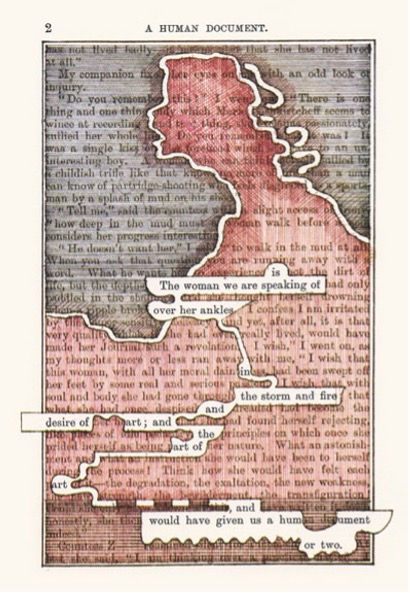2.0 ‘Erasure’ is a term that – for better or for worse – has come to describe a broad set of poetic practices that go beyond being merely influenced by a text, to using it as direct raw material. In a special case of more general postmodern magpie appropriation, a basic description might be: a new poetic text excised from the particular sequence of words in other some already existing text. The term – complicated by more recent additional use to point out oppressive cultural erasure – comes from the common technique of removing words (say by means of a black marker or white correction fluid) to form a poem with what remains.
2.1 The most often-cited touchstone is Ronald Johnson’s Radi Os (Sand Dollar Press, 1977; reissued by Flood Editions, 2005), which springs ever so partially forth from Milton’s Paradise Lost (paRADIse lOSt), conjuring a modern vision from the 17th Century epic. Gone are Satan and God – at least in explicit name – and what persists focuses on the elemental universe in a manner befitting of our burgeoning ecological consciousness rearing its head into the end of the 20th Century. See also: Tom Phillip’s A Humument (Tetrad Press, 1973) from the 19th Century novel A Human Document, Jen Bervin’s Nets (Ugly Duckling Presse, 2004) from the sonnets of William Shakespeare, Janet Holmes The MS of My Kin (Shearsman, 2006) from the poems of Emily Dickinson, Mary Ruefle’s A Little White Shadow (Wave Books, 2006) from a 19th Century novel of the same name, M. NourbeSe Philip’s Zong! (Wesleyan, 2008) from a 1783 legal document describing the insurance claim from a slave ship whose cargo drowned at sea, Travis MacDonald’s The O Mission Repo (Fact-Simile, 2008) from the 9/11 commission report, Srikanth Reddy’s Voyager (California, 2011) from the memoir of former UN Secretary General Kurt Waldheim, and trans writer Chase Berggrun’s R E D (Birds LLC, 2018) from Bram Stoker’s Dracula to mention only a few.
2.2 Yet for all their collective association, contemporary works of erasure reveal as high a degree of diversity in the details of their particular methods as in any other sector of poetic creation. Many such as Radi Os attempt to preserve the placement and relative positions of their chosen words, with the ‘erased’ text in a sense still present through great haunting lacunae on the page. In others like Voyager, the products of mining the source text are reconstituted for publication more on their own terms. Others still in the vein of A Humument deploy lavish illustrations, bright colours, and detailed geometry to isolate and yet also connect words and phrases to be read on full reproductions of the source text’s pages – becoming such a layering up as to make a mockery of that label ‘erasure’.

2.3 Besides questions of the subtractive versus the additive, some projects may traverse their sources in a singular journey from beginning to end (Radi Os, A Humument, A Little White Shadow), while others instead sample their attendant material over and over until the new poem emerges by way of iteration (Zong!, Voyager). And, of course, the textual fountainhead may run the full gamut from high literature to cases of the most unpoetic language.
2.4 So the sculpture hewn out of a block of marble metaphor is not universally available to us here – excavation not always in question. Rather, what I have begun to see in common across works of so-called erasure poetry is a kind of intensive process more akin to the deepening of image resolution. We must admit to a real difference in the relationship between source text and erased poem, and that of the same footage in 2K scaled up to 4K. But there is something in the way the original text in a work of erasure remains in spite of any transformations, yet is still re-sampled and looked at again with a distinct intensity. As Steve Yedlin is at great pains to point out, resolution factors and sampling algorithms each possess their own characteristics that demand going beyond blind faith in quantitative increases automatically yielding commensurable qualitative leaps, but moreover their idiosyncrasies must become part of cinematic artistry and decision making. Just as a 4K master from a 2K source does not fundamentally introduce any new material beyond statistical procedure, the work of erasure must find its new depths from what is already present, while the particular techniques (algorithms?) deployed may bring varying concerns to bear on the mechanics of language and poetry, or the relationship between text and world.













